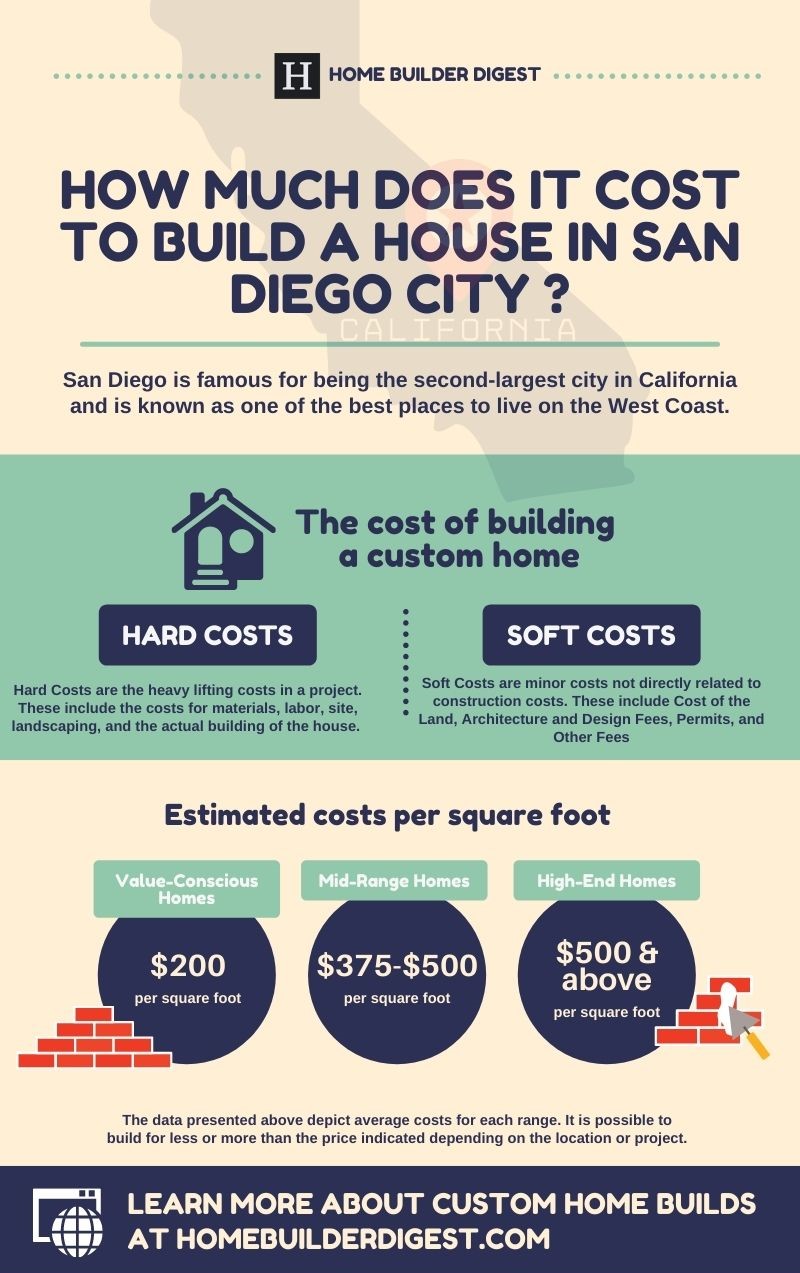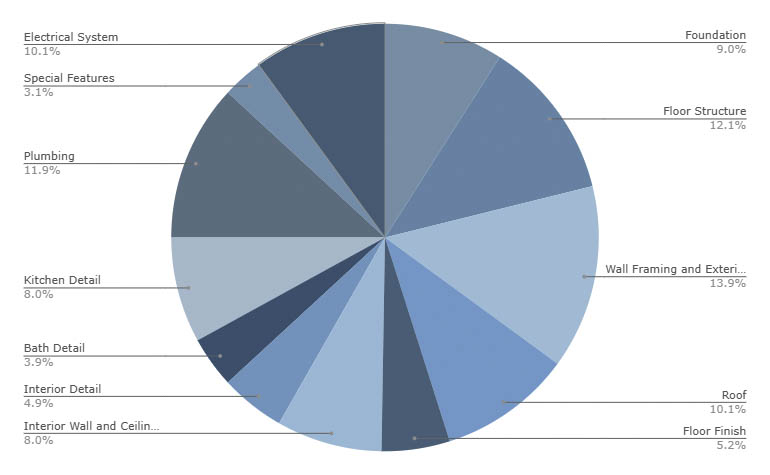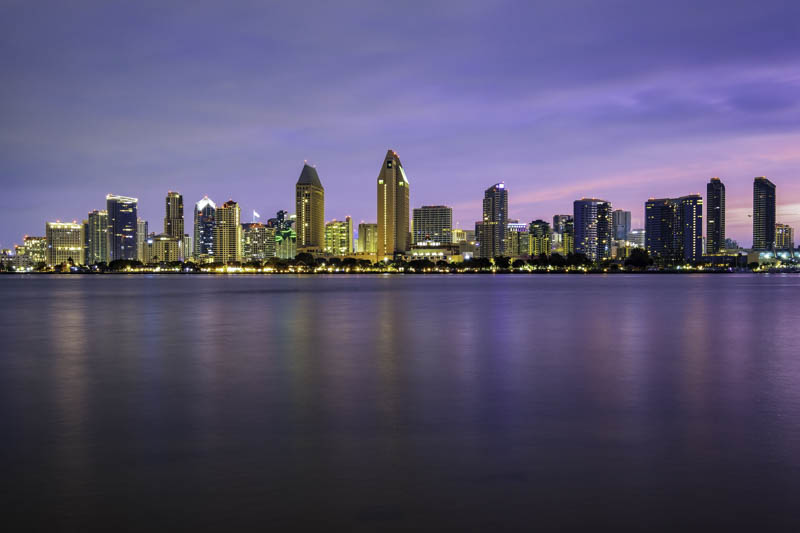Home » Cost Guides » California Cost Guides » How Much Does it Cost to Build a House in San Diego?
San Diego is the second-largest city in California. Like Los Angeles, the city is a jewel of a location and is known for being one of the best places to live on the West Coast. With a collection of beautiful beaches, pretty neighborhoods, and great food, San Diego has become a city filled with diverse people.
Over the decades, it has stood host for different and high-demand vocations including tech, healthcare, research, tourism, and military work. This well-supported economy has resulted in high median home prices. But what construction costs and fees should a potential homeowner consider when investing in a San Diego residence?
The cost of building a custom home in San Diego

The average U.S. home of about 2,600 square meters costs roughly $400,000 (about $150 per square foot) but that can go up to $700,000 or more depending on greatly varying factors.

Figure 1. Typical cost breakdown of a single-family home constructed using the conventional method, according to Home Builder Digest. Image Source: National Cost Guide.
In California, the standard single-family home costs around $148 to $225 per square foot. On average, these regular homes can cost about $173 per square foot. Semi-luxury private homes meanwhile would cost around $229 to $350 per square foot with an average of $270 per square foot, while a luxury home would cost $376 to $576 per square foot with an average of $444 per square foot.
From the indoor and outdoor living spaces to the porch and garage, the total estimated buildable area of the home is fully calculated.
On average, building a custom home in San Diego can cost approximately $225 to $350 per square foot, but this is only a general price. As a custom home, the costs can greatly vary depending on a number of reasons. These include the location, size, cost, and characteristics of the land alongside the home’s design, its interior finishes. Among the different factors that play to a home’s expensiveness, the framing, foundation, plumbing, roofing, and flooring are the most expensive factors in building a home. When it comes to architecture and design fees, costs also trickle down to construction costs, builder fees, permits, and other additional custom features. According to housing researchers, two-thirds of the home building cost comes from materials and labor. In California, both are pricey and are still rising. These costs are also divided into two factors: the hard and soft costs.
Hard Costs
From the materials, labor, site, landscaping, and the actual building of the project, hard costs involve the heavy lifting that builds the house. In San Diego, entry-level homes or value-conscious homes usually cost $200 per square foot. Custom home design development would make up 5% to 8% of the budget reserved for a custom home. These entry-level residences present straightforward designs, lack the flaunt of luxury, and focus on utilizing cost-friendly fixtures and finishes.
On the other hand, mid-range custom homes would have a few custom details and unique architectural features that have been crafted with higher quality materials like glass and steel and present distinctive architectural features. These materials alone could contribute to the costs usually amounting from $375 to $500 per square foot.
High-end homes can go higher than $500 per square foot for dominating over a larger and expansive patch of land, are high performing, and emphasize the homeowner’s choice of materials and fixtures. A Manta report on custom home builders costs in the city in 2021 shows that the majority of homeowners paid an average of $67,550 in total for labor, cost of materials and equipment, and other project costs, with the minimum at $14,474 and the maximum at $120,627.
It should be noted that these costs are actually still separate from city/county fees and site development. These fees can range from $30,000 to $50,000 and there are between 12 to 30 categories depending on the site location and would go to various costs such as fees for park and recreation, green, drainage, water meter, grading, sewer, and traffic impact bonds among many others. For Californian homes, most of the big costs originate from pricey materials like wood timber, concrete, and cement. According to the California Building Industry Association, the previous administration’s tariffs drove up the costs of a new average-sized California home up to $20,000 to $30,000. These higher prices were the result of costly materials ranging from household appliances, nails, lighting, laminate, tile, cabinets, and other materials made from aluminum, steel, and lumber. Before this spike in prices, however, California already was a costly place for building a home. According to many experts, these home prices could actually climb higher within the next few years, forced upwards by the shortage of housing supplies and hyperactive home buyers.
Soft Costs
Soft costs are additional minor costs that don’t involve any heavy building and are not directly related to the construction costs. These costs mostly involve:
Cost of the Land
The site location accounts for a big chunk of the cost to build a house and helps determine the design and features of a home. It can be a challenge to find undeveloped land close to town as opposed to rural areas. It becomes a toss-up between wanting more privacy and acreage for customizing a home or having better access to roads and utilities.
Real estate company Pacific Beach Homes reports that an average plot of land in the Pacific Beach area of San Diego can go for around $1,000,000, while in East, North, and South county the average lot sells between $50,000 to $300,000.
A home’s source of water supply will also be affected by its location. Water tables vary from property to property and will need to be checked by a specialist to see if building a well to access underground water is feasible. Wells can cost about $10,000 to $20,000 to set up and usually need a pump powered by electricity. A filter makes the water potable, and the well may need some maintenance over the years but will have no usage fee. In contrast, connecting to city water can cost $20,000 or more depending on your proximity to the city and requires a usage fee to cover quality maintenance.
The same is true for electricity and gas. Coordinating with a local power company will involve research on their part, the cost of which may factor into the installation fee. Pacific Beach Homes shares that San Diego Gas and Electric normally charges $1,800 for this initial engineering report, while installation fees range from $5,000 to $20,000.
If going that route proves expensive as a whole, solar and propane are also options. Solar power has become popular recently for its efficiency. Installation fees will vary depending on the size, quality, and placement of solar panels, but a system for an entire house can cost around $20,000 for panels and $20,000 for the batteries. Propane tends to be a bit cheaper, but will need proper set-up to ensure safety. Installation will cost around $2,000 to $5,000. Solar and propane may require a heftier upfront set-up fee, but no monthly fees. Solar batteries will need to be replaced every five to seven years, costing $4,000 to $6,000 each, while propane will need to be refilled.
Permits and Other Fees
In San Diego, there are several permit fees that will depend on what area of the county the site is on. To support the schools in the neighborhood where a home is being built, school fees are charged based on assessable space, which includes the main living areas in the house plus external spaces such as porches and swimming pools. These fees will vary depending on what school district the home is being built in, but Brian Freeman of The Freeman Group of real estate and construction companies says they typically range from about $3.50 to $4.50 per square foot. Traffic impact fees can range anywhere from $3 to $5,000 depending on the area. Park fees will cost about $4,500 for a 2,200-square-foot home.
More fees will come in as site work begins. Each home will require a new septic system. Choosing to tie into city water will require paying water meter fees on the front end, which normally cost upwards of $15,000 each. Total cost for setting up the septic system ranges between $25,000 to up to $40,000. If a percolation test would be necessary to identify the proper design for the system, its cost would be in the $3,500 range, depending on the lot. The test can be waived, however, and just be based on the rates for neighboring lots.
Once the plan for the home is ready, submitting it to the county will require payment of an initial fee for checking. Then there will also be fire mitigation fees, building permit fees, and covered inspections. For a 2,200-square-foot home, these will amount to roughly $8,000 altogether.
Architecture and Design Fees
It would benefit would-be homeowners greatly to partner with an architect who understands both their needs and the site they are building their home on. Often, this will entail an investigative study to identify the complexities of the site: zoning requirements, open easement restrictions, homeowners’ association requirements, topographical character, etc. This will help in the development of the home’s design and the requirements to achieve it.
In total, architects’ fees can range between 5% to 8% of the budget for your custom home, although this can still vary between firms and based on the complexity and requirements of the home.
How do the custom home building costs in San Diego compare to other nearby cities?
In California alone, costs to build a house area already exceed the usual price. According to the California Legislative Analyst’s Office, California’s building codes and standards are considered more comprehensive and prescriptive which often results in the requirement of more expensive materials and labor. For example, builders in the state are required to use higher quality building materials for windows, insulation, and heating and cooling systems. This is all to achieve the state’s energy efficiency goals. The coastal nature of the area, as well as the mountains that surround it, also pose additional challenges to building. According to The San Diego Union-Tribune, in 2019, San Diego county’s median home price was pushed up by a declining inventory and dropping interest rates that increased home prices to $594,455. A newly built traditional single-family house can cost up to nearly $1 million, sometimes even higher. By 2021, San Diego home prices for single-family residences have hopped up 19.6% year over year until they reached a staggering $860,000. According to building estimating blog Estimation QS, this puts San Diego at 8% more than the national average, but 9% lower than San Jose’s 17% average. Such a heavy price can also be due to a new home’s proximity to job centers. The closer a residence is to downtown spaces, the more expensive. In Carlsbad’s Cypress at The Preserve, for instance, home costs can start at $782,990 while homes in Escondido’s Oak Creek can cost $750,000. Meanwhile, homes in Pacific Highlands Ranch near Carmel Valley can start at a staggering $1.4 million.
Records of permits found on the online contractor platform BuildZoom (BZ) show new construction of single-family homes in the nearby cities of El Cajon and La Mesa valued between $400,000 and $500,000.
Major Custom Home Building Cost Trends Across the Web for San Diego
Based on gathered sources like online market platforms, Homeadvisor, Manta, and online discussion forums, the average costs that make up a custom home in San Diego county can range from $300 to $500 per square foot or more depending on the different factors discussed in this article. According to some market segments, referenced from digital market platforms like Manta and Homeadvisor, and other online forums on home building, building the average 1,218 square foot home in San Diego would cost approximately $365,400. A 500-square-foot home meanwhile could reach up to $1,680,000 and cost much more depending on the square footage, and other elements like the soft costs and if the overall design of the house is more custom than the average home.
What Leading Custom Home Builders and Architects that Serve the San Diego Area Say?
We reached out to some of the best custom home builders and architects that serve San Diego to find out their thoughts on building cost trends in the area. Acknowledging the common sentiment that today’s market can be a little difficult to estimate due to the changing cost of materials, they say the cost per square foot can start at $350, with mid-range homes at $400 on the low end, and luxury homes costing up to $1,500 or more.
Custom home builder Charco Design Build President and CEO Armando Flores says these estimates depend on factors such as material selections and lot preparations. Windows, for example, can cost anywhere from $150 to $4,000, while homeowners can spend $20,000 to $250,000 to get a site ready. Gas prices also affect the cost of delivery of materials, as seen in the upward trends for steel and lumber today. The pandemic has also made it difficult to hire labor workers, while the construction boom has also created a backlog of projects. Permit application processes have also been significantly prolonged. The firm advises homeowners to “do your homework” when it comes to choosing who to work with. It’s best to make sure all the paperwork is taken care of and to ask the right questions, especially about the inclusions of the project, to avoid any surprise costs later on.
John OBrien, founder and president of design-build firm Flagg Coastal Homes confirms the increase in materials costs: “In both of our current ‘New Builds’ we have seen the lumber and framing costs swing dramatically from initial bid to actual construction, approaching $9.00 per square foot swing. That is framing and lumber alone.”
The firm continually monitors the federal reserve’s FRED Index for construction material costs to be able to adjust their purchases of appliances, tile, countertops, windows, flooring, and other materials according to price fluctuations, in addition to materials availability and delivery constraints. It has also observed an increase in municipal fees as a result of state-imposed drainage requirements and solar mandates. “All of our project’s ‘critical path’ is dependent on Utility Permits and Inspections. We operate at the mercy of SDG&E,” says OBrien about the crucial role project scheduling plays. Nevertheless, the firm does its best to hurdle all the challenges of designing, permitting, and building its projects to make things easier for its clients.
Founding Principal Architect Mark House of House Design Architects also attests to the supply issues that have arisen from the pandemic, saying, “costs are all over the place. We have seen prices for lumber go up by multiples. Concrete, steel, and copper are all up.
Some products like paint, wood molding, and spray insulation base materials are hard to find and have gotten more expensive. Making this worse is the fact that construction is very busy, so you have a lot more people chasing limited resources.”
He and the colleagues and contractors he has spoken with agree that perhaps things will start to normalize with the economy reopening, but this may not happen fully until well into 2022.
The firm is currently designing a modern farmhouse-style home in Encinitas with a high level of materials and finishes that is coming in at $560 per square foot, including the accessory dwelling unit (ADU) structure. “I think a range of $500 to $600 will get you a very nice custom high-end level of house. From there, integrating in a higher level of detail, optional features, and systems you can go up to $1,200 to $1,500 for a very high-end home,” says House. He also consulted with a partner contractor for a young couple looking to build in the Carmel Valley area who have a more limited budget. The estimate so far is $400 per square foot, being careful to avoid complicated details and features. “A few years ago $350 per square foot would get you a very nice house.”
House says the biggest variable between projects tends to be site costs. “A project that has already been graded or that is fairly level, has a lot less site costs as opposed to a hillside lot that may require extensive grading, foundations, or caissons as needed to develop a house. The time to construct a house on a hillside or heavily graded site is also much longer and therefore costs more money.”
He ends by saying, “There are a number of reasons I hear why people are building now in Southern California. People have stockpiled money to build now. Interest rates are very low. The listed cost per square foot for houses that are selling is very high. Housing is a good hedge against expected inflation. It looks like prices will only go higher. Lastly of course, given all the storms and bad weather elsewhere, Southern California is a great place to live.”
The Future of San Diego’s Residential Construction Industry
Many experts say the factors that have pushed up prices in 2020 will likely continue in 2021 and beyond, especially low inventory. According to some online forums and market reports, San Diego’s 2022 residential construction market sector, which has gone up by 22.5% over the past year, will continue to rise at a similar pace in the next 12 months.
As with the residential set-up throughout the rest of California, adding accessory dwelling units (ADUs) onto existing lots is also becoming increasingly popular, with many contractors paying close attention to the developments with city regulations for building such. The city is also seeing the move towards transit-oriented developments, which often include multifamily residential buildings situated amidst office and retail complexes.
Considering building a home in San Diego?
Contact us for a free consultation

